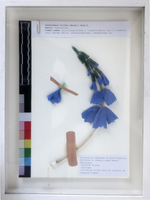Items
Site
The Medicine Chest
keywords is exactly
mimicking
-

Foxgloves
Called variously foxgloves, witch’s gloves, dead men’s bells, fairy’s gloves, bloody fingers, gloves of our lady, fairy caps, virgin’s gloves or fairy thimbles, Digitalis purpurea is popular with children, who pluck the tempting bell-shaped blooms and wear them like thimbles, admonished not to lick their fingers afterwards for fear they will go blind (Young 2002: 57). While the flower can be lethal if ingested, the drug digitalis derived from foxglove is most commonly used as a heart stimulant. Digitalis has been prescribed since the 17th century, perhaps earlier, as a diuretic and to slow the pulse and is still the drug of choice for atrial fibrillation. In the 1770s, William Withering got an old family recipe, a herbal infusion for treating swollen legs, from a Shropshire woman and identified digitalis as the active one of the twenty ingredients. Many more antiarrhythmic drugs now exist (Young 2002: 57). Made up of surgical gloves, Band-Aids, syringes and IV-tubing (with an infusion of foxglove leaves in its stem) the work mimicked the language of the herbarium specimen, drawing a viewer in to examine the content they were expecting, only to surprise them with its incongruous materials. -

Resonance (Greenblatt)
In 'Resonance and Wonder' Greenblatt discusses ‘resonant’ moments in regards to museum displays as “those in which the supposedly contextual objects take on a life of their own and make a claim that rivals that of the object that is formally privileged. A table, a chair, a map – often seemingly placed only to provide a decorative setting for a grand work – become oddly expressive, significant not as a background but as compelling representational practices in themselves. These practices may in turn impinge on the grand work, so that we begin to glimpse a kind of circulation: the cultural practice and social energy implicit in mapmaking is drawn into the aesthetic orbit of a painting, which has itself enabled us to register some of the representational significance of the map” (1991: 22- 23). For him a resonant exhibition often “pulls the viewer away from the celebration of isolated objects and toward a series of implied, only half-visible relationships and questions” (1991: 23). -

Resonance
Image from page 137 of the 'Curiosity CLXXV' catalogue, describing resonance and its application in MRI technology.


